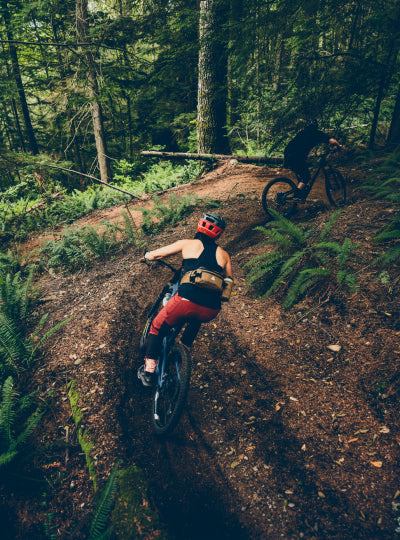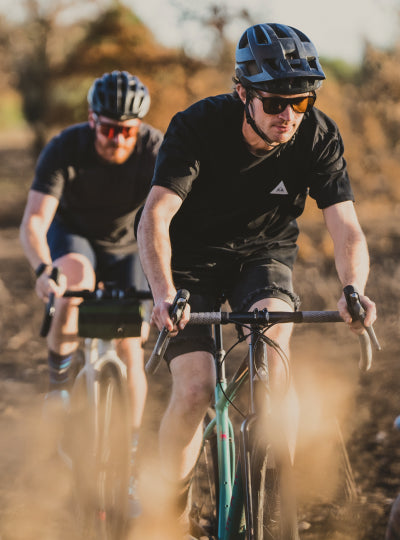If you've already gone down the rabbit hole of internet reviews and forum debates as to “what the best flat pedal is”, you'll notice a common theme...they're all very subjective to the riders' style and the terrain they ride. That's not always helpful if you ride in a completely opposite style and terrain as the reviewer, leaving you more confused or misinformed as to what's best for you. For instance, if you live in a super rocky area, durability and maximum ground clearance might be important to you. Or if you like to dirt jump or drift turns with your foot out moto-style, a pedal that doesn't spin freely might be appealing. We're here to discuss the ins and outs and pros and cons of what type of pedal to choose based on the two most common materials used in flat pedals: alloy or composite.
Alloy Pedals
Alloy pedals go back to the first Beartrap pedals found on BMX Freestyle bikes in the 80s that made their way onto early MTBs, (this was especially appealing for those of us that didn’t want to use the death trap style toe straps at the time). Of course, they had their limitations, especially in terms of grip, but man did that calf tattoo look sweet when you slipped a pedal. We've come a long way since then.
With most modern alloy pedals, there comes an extra level of strength over a composite pedal. This can be a good thing or a bad thing depending on your preference. Love durability? These pedals can take their fair share of abuse, especially on rocky trails, and they tend to keep on going for miles to come. Like a squeaky clean look? Alloy tends to show its scars due to a long life of battling all the trail goblins trying to snag your pedals over the years, scraping away the anodized color.
Premium alloy pedals often use high-end sealed cartridge bearings for their main bearing that spin freely. This is a great plus for general trail riding and all-day adventures where every watt savings might matter, but not always preferred among riders who tend to take their feet off the pedals, like dirt jumpers or those who rally their turns foot out, flat out. So it's a good thing to consider when you're picking your flat pedal poison.
Lastly, aluminum is a stiffer material than composite, so you can make a pedal thinner. This means you'll have more ground clearance from all the carnage beneath you, and your foot will sit closer to the axle of the pedal, leaving you feeling more connected to the bike.
Composite Pedals
Composite pedals are nothing like those sketchy “test ride” pedals that come with most bikes, which are not made for prime-time trail riding. Like our Range Pedal, many composite pedals are made from glass-reinforced nylon which is a cost-effective and durable material designed to take a bit of abuse (especially on your low bottom bracket 29er trail machine). Because composite isn't as stiff as aluminum, this usually results in a thicker pedal than its metal counterpart to achieve the strength needed. While composite may not be as strong as alloy, the material's natural ability to slide off trail goblins and not get hung up on a rock if you do contact one is an added plus. And if you do inevitably strike that rock, unlike an anodized alloy pedal that only colors the surface and will show raw aluminum if scratched, composite pedal colors are created by dyeing the entire composite material, so any scratches from pedal strikes will be less noticeable because it's all the same color throughout.
On the bearing side of things, many composite pedals use a bushing for the main bearing in place of a sealed cartridge bearing found on more premium alloy pedals. This is a more affordable solution over a large, sealed cartridge bearing, but the upside is that also ends up being lighter. Since composite is already a lighter material than aluminum, this combo results in an overall lighter pedal than its alloy sibling. Lastly, because of that bushing, if you like to do one-footers or moto-drag race corners, these will stay in place once you've removed your foot so you can easily find the platform when its time to get back to business.
Which Pedal Is Right For You?
Which pedal is right for you comes down to personal preference, riding style, aesthetics, and budget. Both alloy and composite pedals are up to the task of any style of flat pedal riding (trail, downhill, dirt jump, gravel, commuting, etc.). From our $49 Range Composite Pedal to the $99 Loam Alloy Pedal, there's an option for every budget.
As we've discussed, our Loam Alloy Pedal, with its slightly thinner and more durable aluminum pedal body, might be a better option for anyone riding in areas with lots of tall roots and rocks, or riders with lower bottom bracket heights - all of which would benefit from the strongest material and most ground clearance possible. The smooth, friction-free main bearing of the Loam will serve the most die-hard Strava users going after that next KOM. And if that anodized alloy look is your peanut butter, the Loam Alloy Pedal is your jam.
The Range Composite Pedal, with its bearing system that holds the pedal in place when a foot is removed, might be a better option for dirt jumpers, trail riders, and downhillers who like to take their feet off to throw tricks and rail turns foot out. If the lightest option is a priority, the Range Composite Pedal's lighter-weight material and bushing check that box. And with 7 color options, the Range Composite Pedal offers the most options to match any scheme, and when you do clip a pedal, those colors will help hide the scars.
If you still need some help deciding, hit us up at info@pnwcomponents.com or (206) 678-0419 and we'll help you land on exactly which option is best for you.










